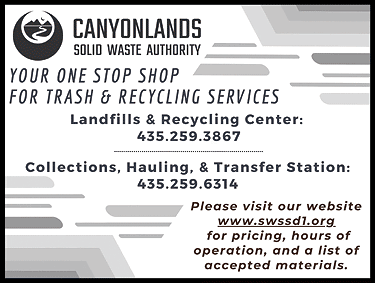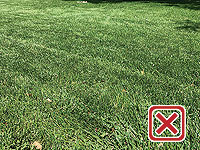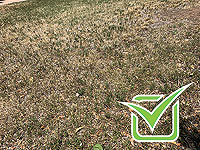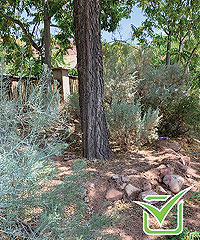|
|
SUSTAINABILITY HAPPENINGS - August 2021
|
The Quick Guide to Sustainable Tourism in Moab
by Jessica Thacker, Program Manager Canyonlands Solid Waste Authority |
Welcome to Moab – the recreational playground of Utah where red rock towers soar, the exhilarating Colorado River wanders through carved canyons, and breathtaking panoramas await around the bend. Moab and its surrounding wild country have endured for many years, yet can be diminished or even destroyed in the blink of an eye if not treated with the upmost respect and revery. When visiting Moab, you too can be a steward of the local landscape – leaving the land just as stunning for future generations. But how does one accomplish this in a relatively unknown destination and why is it so important?
By taking a moment to consider simple but effective behaviors, the sweeping scenery that first enticed you to Moab can be enjoyed by many others for years to come. This can be achieved in the form of sustainable tourism – tourism meant to take full account of its current and future economic, social and environmental impacts, addressing the needs of visitors, the industry, the environment and host communities. In the candid guide presented here, each of these proposed steps address some form of economic, social, and environmental solution to impacts driven by high-scale tourism. This guide is by no means exhaustive, but aims to provide a clear line of responsible visitor behavior that can be both beneficial to tourists and local residents alike.
Moab provides allure to all types of visiting adventurers, artists, connoisseurs, enthusiasts, and thrill- seekers. Whatever you seek in Moab, consider the following:
Treat Your Accommodations Like Home: By doing so, visitors can reduce their impact on natural and local resources such as water and electricity. Moab is geographically isolated and therefore, such resources, are considered invaluable.
Support Local: This can even include when traveling on the road to the next destination. Consider it an unexpected way to infuse revenue into local communities and a way to discover hidden gems along the path.
Stay on the Trail: Respecting the established trail further upholds the untamed land Moab is known for. Just as important, the “black crust” plays a variety of protective environmental functions such as stabilizing the soil, reducing the effects of water and wind erosion, and even acts as a nurturing shelter for young seedlings from extreme weather.
The ABC’ s of Camping: This one is pretty easy: Leave No Trace, Pack It Out, and Respect the Land. Take your recyclables to the local recycling center and dispose of your waste appropriately.
Voluntourism: This idea may seem a little wild, especially for those just looking for a relaxing vacation, but it is something that can easily be achieved by simply picking up litter you might encounter and disposing of it at the local solid waste transfer station or donating leftover non-perishable food from your trip to the local food bank. Voluntourism can be accomplished from the smallest of actions to the grandest of gestures, so long as they truly benefit the local community and environment.
Plan Ahead: Forewarned is forearmed. Being prepared permits visitors to anticipate all of their needs which, in return, reduces the risk of encountering potentially unpleasant or hazardous situations and can guarantee a more authentic and gratifying experience.
Respect Archeological & Culturally Significant Areas: Another simple suggestion. The presence of an ancient peoples’ art and the long-fossilized steps of lumbering giants only further enriches the magic Moab has available to dazzle its many visitors. Let that magic persist, undisturbed and untouched, ready to thrill its next audience.
By working towards more sustainable tourism practices, along with effective implementation of reasonable sustainable practices at the local level, Moab can maintain its distinctive small-town charm, endless starry skies, and the sought-after promise of disconnect from a bustling and overwhelming world.
For more information and resources, visit the Canyonlands Solid Waste Authority website at https://swssd1.org/recycling/recycling-resources/
|
Let’s Talk About Lawns
by Mila Dunbar-Irwin, Moab City Sustainability Director. |
 Have you ever stopped to think why we, as North Americans, grow so much grass? It’s not a commodity crop, it’s clippings aren’t used for anything, it doesn’t produce pretty flowers or even a particularly comfortable surface to sit on. And yet, we grow an estimated 40 - 50 million acres of lawn in the US, about the same as that planted in wheat. So, why do we have all this grass? Have you ever stopped to think why we, as North Americans, grow so much grass? It’s not a commodity crop, it’s clippings aren’t used for anything, it doesn’t produce pretty flowers or even a particularly comfortable surface to sit on. And yet, we grow an estimated 40 - 50 million acres of lawn in the US, about the same as that planted in wheat. So, why do we have all this grass?
It turns out that our lawns are, like tea and starlings, from the British Isles. In the 16th century, lawns were cultivated by the very wealthy, for aesthetic purposes, as a status symbol (due to the sheer volume of human labor required for upkeep), and for some visually defensible space. At the same time, many villages had a “commons” that was an open lawn-like area where their livestock grazed “in common.” Meanwhile, up in Scotland, much of the land is park-like and without trees, and games such as bowling (“bowls”) and golf became popular. When British colonizers came to North America, they brought their affinity for lawns and lawn games, and grass seeds riding in on their coattails.

So, here we are, with our acres of green lawns in the desert instead of their native temperate climate. Without ripping them all up, how do we manage during a drought? Luckily, there are a few key things we can do to save water while saving our grass.
Cut your grass to 3” height and no lower. This will allow the lawn to retain more moisture, encourages deeper roots, and shades soil during the heat of the day.
Water only 3x per week for no more than 45min at a time. Grass is resilient and even if it browns, it will come back when water is more available.
Don’t water between 10am and 8pm. This will reduce water lost to evaporation.
Avoid watering when it is windy! More water is lost to wind than to evaporation; if most nights are windy then watering during the day is preferable.
Prioritize your watering: #1 Trees, #2 Shrubs, #3 Perennials, #4 Annuals, #5 Turfgrass
You can find more information and tips at https://slowtheflow.org/drought-tips/.
And be sure to mention you read about it in Moab Happenings.

|

|
|
|
|
|
|
|
© 2002-2024 Moab Happenings. All rights
reserved.
Reproduction of information contained in this site is
expressly prohibited.
|
|